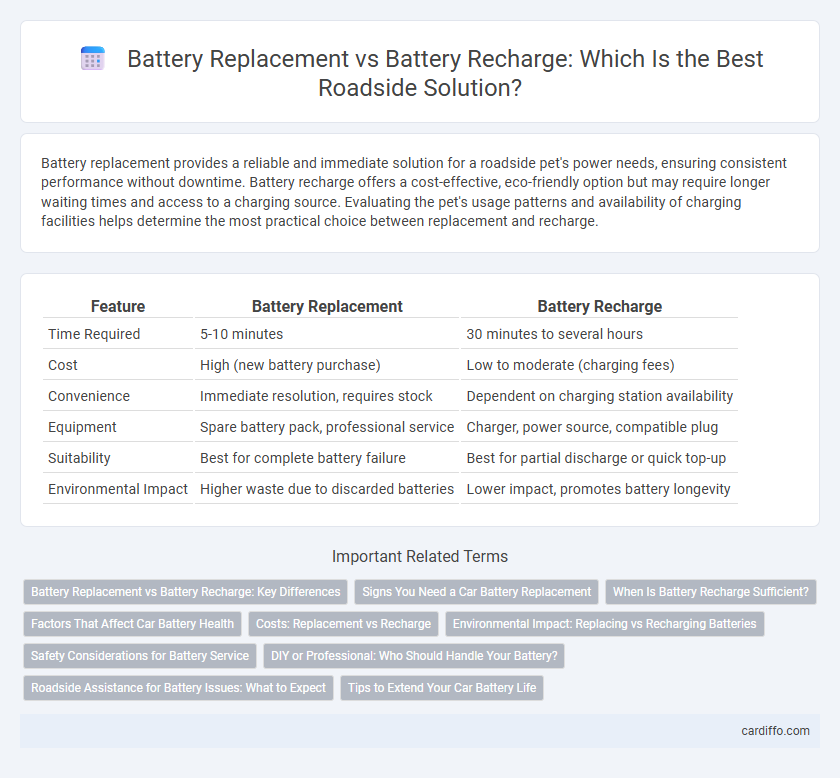Battery replacement provides a reliable and immediate solution for a roadside pet's power needs, ensuring consistent performance without downtime. Battery recharge offers a cost-effective, eco-friendly option but may require longer waiting times and access to a charging source. Evaluating the pet's usage patterns and availability of charging facilities helps determine the most practical choice between replacement and recharge.
Table of Comparison
| Feature | Battery Replacement | Battery Recharge |
|---|---|---|
| Time Required | 5-10 minutes | 30 minutes to several hours |
| Cost | High (new battery purchase) | Low to moderate (charging fees) |
| Convenience | Immediate resolution, requires stock | Dependent on charging station availability |
| Equipment | Spare battery pack, professional service | Charger, power source, compatible plug |
| Suitability | Best for complete battery failure | Best for partial discharge or quick top-up |
| Environmental Impact | Higher waste due to discarded batteries | Lower impact, promotes battery longevity |
Battery Replacement vs Battery Recharge: Key Differences
Battery replacement involves removing the old battery and installing a new one, ensuring long-term vehicle performance and reliability, while battery recharge restores the existing battery's charge without addressing underlying health issues. Replacement is recommended when a battery's capacity drops below 80% or shows signs of failure such as slow engine crank or dim lights, whereas recharge is suitable for temporary power loss due to leaving lights on or short trips. Regular battery testing and maintenance can help determine the optimal solution between replacement and recharge to avoid roadside breakdowns.
Signs You Need a Car Battery Replacement
Dim car headlights, slow engine crank, and frequent electrical issues indicate a failing car battery that requires replacement rather than recharge. If the battery is over three to five years old, even recharging might not restore its full capacity. Corrosion on battery terminals and a swollen battery case are clear signs that replacement is necessary for reliable roadside performance.
When Is Battery Recharge Sufficient?
Battery recharge is sufficient when the battery still holds a charge and shows no signs of physical damage or corrosion on terminals. Modern vehicles equipped with smart battery management systems typically indicate when a simple recharge can restore functionality, especially if the battery is relatively new and hasn't reached the end of its service life. Frequent quick recharges might suggest underlying issues, so a full replacement is recommended if performance declines persist after recharge attempts.
Factors That Affect Car Battery Health
Car battery health is influenced by factors such as temperature extremes, driving habits, and electrical system demands, which determine whether battery replacement or recharge is necessary. Frequent short trips prevent full battery recharge, accelerating deterioration, while prolonged exposure to heat or cold reduces capacity and lifespan. Regular maintenance and monitoring voltage levels help optimize battery performance and decide the appropriate roadside service.
Costs: Replacement vs Recharge
Battery replacement costs typically range between $100 and $300, depending on the vehicle and battery type, while battery recharge services usually cost between $20 and $50. Replacement involves purchasing a new battery, which can provide longer-term reliability but at a higher upfront expense. Recharging is a more affordable short-term solution, ideal for extending battery life without the immediate investment of a full replacement.
Environmental Impact: Replacing vs Recharging Batteries
Replacing car batteries generates significant hazardous waste, including lead and acid components that require specialized disposal to prevent soil and water contamination. Recharging batteries reduces environmental harm by extending battery life and decreasing the demand for new battery production, which involves resource-intensive mining and manufacturing processes. Opting for recharging promotes sustainability and lowers the carbon footprint associated with battery lifecycle management in roadside assistance scenarios.
Safety Considerations for Battery Service
Battery replacement requires careful handling of hazardous materials such as lead-acid or lithium-ion cells to prevent chemical burns and environmental contamination. Proper personal protective equipment (PPE) and adherence to safety protocols during battery recharge reduce risks of electrical shock and thermal runaway. Ensuring ventilation and using certified chargers are critical steps to maintain safety during battery servicing roadside.
DIY or Professional: Who Should Handle Your Battery?
Replacing a car battery requires specific tools and knowledge to safely disconnect and install the new unit, making professional service a reliable choice for most drivers. While battery recharge can often be a DIY task using a compatible charger, improper handling risks electrical damage or incomplete restoration. Understanding the difference in skill level and equipment needed helps determine if a roadside battery issue is best left to trained technicians or manageable as a quick personal fix.
Roadside Assistance for Battery Issues: What to Expect
Roadside assistance for battery issues often includes both battery replacement and battery recharge services, depending on the battery's condition and the situation. Battery recharge can provide a quick boost to get your vehicle started if the battery is simply drained, while battery replacement is necessary when the battery is dead or beyond recovery. Professional roadside technicians carry specialized tools for testing battery health and offer on-the-spot solutions to minimize downtime and ensure safe vehicle operation.
Tips to Extend Your Car Battery Life
Regularly check battery terminals for corrosion and clean them to ensure optimal electrical connections. Minimize short trips that prevent full battery recharge by combining errands for longer drives. Use a battery maintainer or trickle charger during periods of inactivity to keep the battery at an ideal charge level.
Battery replacement vs battery recharge Infographic

 cardiffo.com
cardiffo.com